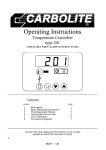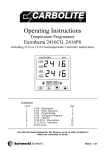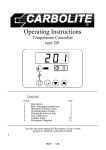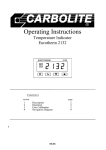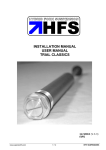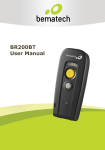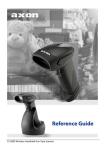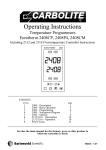Download Carbonite Furnace HST User's Manual
Transcript
Installation, Operation & Maintenance Instructions 1200°C Split Tube furnaces types HST & VST This manual is for the guidance of operators of the above Carbolite products and should be read before the furnace is connected to the electricity supply. CONTENTS Section 1.0 2.0 3.0 4.0 5.0 6.0 7.0 8.0 9.0 page Introduction Installation Operation Maintenance Repairs & Replacements Fault Analysis Circuit Diagrams Fuses & Power Settings Specifications 1 3 5 7 8 11 12 15 16 Manuals are supplied separately for the furnace controller (and overtemperature controller when fitted). Please read the controller manuals before operating the furnace. 1.0 MF13 – 3.31 HST, VST INTRODUCTION 1.1 VST & HST models The VST range comprises split tube furnaces designed for use vertically, with several mounting options: the furnace may be provided with no stand; or with a wall bracket; or it may be fitted to one of two stand designs – near and far. The HST range uses the same insulated split case as the VST, fitted inside an outer case designed for horizontal use – though this may be fitted to an L-stand which allows for both horizontal and vertical use. All models have a separate control box connected by electrical conduits or leads. 1.2 Voltage and Power Control All models in this range, from March 2001, are supplied with heating elements designed for use over the voltage range 200V-240V or 3-phase equivalents. The Carbolite control system incorporates a “power limit” which effectively limits the voltage to 208V. It is most important that any alternative system provided by the customer should be able to limit the power accordingly. See sections 3.6 and 8.2. 1.3 Switches and Lights Supply Light: when the furnace is connected to the electrical supply the light in the adjacent switch glows Heat Switch: the switch disconnects power to the heating elements; unless this switch is off there is a danger of electric shock when inserting objects into the furnace Heat Light: the adjacent light glows or flashes to indicate that power is being supplied to the elements 1.4 Warning Symbols DANGER of electrical shock– read any warning printed by this symbol. DANGER – hot surface. Read any warning printed by this symbol. WARNING: all surfaces of a furnace may be hot. 2.0 2 DANGER – read any warning printed by this symbol. MF13 HST, VST INSTALLATION 2.1 Unpacking & Handling When unpacking or moving the furnace always lift it by its case or main body. Never lift it by its insulation or by a fitted work tube. If possible use two people to carry the furnace and remote control box. Remove any packing material from inside the furnace before use. If an optional or special stand is separately supplied, assemble the furnace on to it. These models may be supplied for customer mounting and may require customer preparation of mounting components before installation. 2.2 Siting Place the furnace in a well ventilated room, away from other sources of heat, and on a surface which is resistant to accidental spillage of hot materials. Do not mount the furnace on an inflammable surface. Ensure that there is free space around the furnace. Do not obstruct any of the vents in the control box: they are needed to keep the controls cool. Ensure that the control box is placed in such a way that it can be quickly switched off or disconnected from the electrical supply - see below. 2.3 Setting Up If the furnace is supplied with a work tube or any accessories fit these into position. For optimum temperature uniformity, insulating plugs should be placed in the tube ends as shown in fig.1. With a long inner work tube, the stem of the plug assembly should line up with the end of the tube as in fig.2. Alignment of radiation shields is similar to that of plugs. With these models, split end plugs are supplied; unless ordered for a specific tube size, these require shaping to fit the tube or work piece: use a round file. If stainless steel seals with gas inlets are supplied they are to be fitted as shown in fig.3; the stem of any insulating plug should touch the seal. Stainless steel seals for vertical use: a hook and eye arrangement holds the upper insulating plug assembly; alternatively a gland nut. Horizontal models: if heavy fittings are to be clamped to the end of an extended work tube they can increase the bending stress at the centre of the tube. Support such fittings in such a way that expansion of the tube is allowed. If a metal work tube is being used in the furnace, ensure that it is earthed for operator safety. MF13 3 HST, VST 2.4 Electrical Connections Connection by a qualified electrician is recommended. The furnaces covered by this manual normally require a single phase A.C. supply, which may be Live to Neutral non-reversible, Live to Neutral reversible or Live to Live. Some models may be ordered for 3-phase use (and if so, are “universal” – see section 2.5). Check the furnace rating label before connection. The supply voltage should agree with the voltage on the label, and the supply capacity should be sufficient for the amperage on the label. If the actual supply is not the same as the voltage on the label, then the controller power limit may need to be adjusted: set the Heater Switch to off, connect the furnace and see section 3.6. The supply should be fused at the next size equal to or higher than the amperage on the label. A table of the most common fuse ratings is also given in section 8.1 of this manual. Where a supply cable is present there are internal supply fuses: customer fusing is preferred but not essential. Furnace with supply cable: either wire directly to an isolator or fit with a line plug. Furnace without supply cable: a permanent connection to a fused and isolated supply should be made to the internal terminals after temporary removal of the furnace back panel. Connection by line plug: the plug should be within reach of the operator, and should be quickly removable. Connection to isolating switch: this should operate on both conductors (single phase) or on all live conductors (three phase), and should be within reach of the operator. The supply MUST incorporate an earth (ground). CONNECTION DETAILS Supply Terminal label L 1-phase N PE supply Terminal label L1 2- or 3-phase L2 L3 N PE Cable colour Brown Blue Green/Yellow Cable colour Black Black Black Light Blue Green/Yellow supply type Live-Neutral Reversible or Live-Live To live to either power conductor To neutral to the other power conductor To earth (ground) to earth (ground) to phase 1 to phase 2 to phase 3 except 2-phase to neutral except delta to earth (ground) Do not connect a furnace ordered for three phase use to a single phase supply or to the wrong type of three phase supply – except as indicated in sections 2.5 and 7.7. 2.5 “Universal Wiring” (year 2000 onwards) When (and only when) ordered for 3-phase use these furnaces are supplied in a form in which they can be easily rewired between 1-phase and 3-phase supplies. This applies to 3-phase+N and 3phase delta in the ranges 380/220V–415/240V and 200-240V, but does not apply to 3-phase star without neutral (e.g 380V or 440V). To alter the configuration, remove the control box back panel and alter the connections between the supply terminal block and the EMC filters, using the appropriate diagram from section 7.7. Models ordered for single phase only are not affected and cannot be converted to 3-phase. If in doubt, please consult Carbolite. 3.0 4 MF13 HST, VST OPERATION The instructions for operating the temperature controller are given in a separate manual. If the furnace is fitted with a time switch, see also the supplementary manual MS03. If cascade control is fitted, see the supplementary manual MS07. 3.1 Operating Cycle The furnace is fitted with a combined Supply light and Instrument switch. The light is on whenever the furnace is connected to the supply. The switch cuts off power to the control circuit. There is also a Heater switch which can be used to disconnect power to the elements. Connect the furnace to the electrical supply. The Supply light should glow . Operate the instrument switch to activate the temperature controller; the O position is off, the I position on. The controller becomes illuminated and goes through a short test cycle. Set the temperature controller to the desired setpoint or program - see the controller manual. Overtemperature option only. If the overtemperature controller has not yet been set as required, set it and activate it according to the instructions in the appropriate manual. Switch on the Heater switch, located on the instrument panel. Unless a time switch is fitted and is off, the furnace starts to heat up. The Heat light(s) glow steadily at first and then flash as the furnace approaches the desired temperature or a program setpoint. Overtemperature option only. If the overtemperature trip operates then an indicator in the overtemperature controller flashes, and the heating elements are isolated. Find and correct the cause before resetting the overtemperature controller according the instructions supplied. To switch off power to the heating elements, use the Heater Switch. To switch the furnace off, use both the Heater switch and the Instrument switch. If the furnace is to be left off, isolate it from the electrical supply. 3.2 General Operating Advice Heating element life is shortened by use at temperatures close to maximum. Do not leave the furnace at high temperature when not required. The maximum temperature is shown on the furnace rating label and on the back page of this manual. 3.3 Operator Safety The ceramic materials used in furnace manufacture become electrically conductive to some extent at high temperatures. In these models there are partially exposed heating coils in the chamber and there is danger of contact even with the furnace closed. DO NOT use any conductive tools within the work tube without isolating it. If a metal work tube is used, it must be earthed (grounded). Switch off the Heater switch whenever loading or unloading the furnace. The elements are isolated when the Heater switch is OFF. This switch cuts both sides of the circuit directly or via a contactor (a contactor is used in models where the rated current exceeds 16 Amps). 3.4 Tube Life A ceramic work tube may be cracked if workpieces are inserted too quickly or at temperatures below 900°C (when the tube is more brittle). Large pieces should also be heated slowly to ensure that large temperature differences do not arise. Poor thermal contact should be encouraged between the workpiece and the tube; crucibles or boats should be of low thermal mass and should have feet to reduce the contact with the tube (fig. 4). MF13 5 HST, VST Do not set too high a heating rate. Large diameter tubes are more susceptible to thermal shock than smaller. Tubes which extend beyond the heated part of the furnace are more at risk. A general rule for maximum heating rate is 400/internal diameter (°C/min); for 75mm i/d tubes this comes to 5°C per minute. The controller can be set to limit the heating rate. 3.5 Pressure Work tubes are not able to accept high internal pressure. When gas seals or similar fittings are in use, the gas pressure should be restricted to a maximum of 0.2 bar (3 psi). A pressure of about half of that should normally be sufficient to achieve the desired flow rate. The customer must ensure that the exhaust path from the tube is not blocked, so that excess pressure does not occur. 3.6 Power Adjustment The furnace control system incorporates electronic power limiting. The power limit parameter OP.Hi is accessible to the operator, and can be used to adjust the furnace to the actual supply voltage. The models covered by this manual (March 2001 onwards) are designed for use over the range of voltages 200V-250V (or, if ordered, 100V-125V), and the power limit parameter is set accordingly. These models may be relocated to a different voltage within the range: the power limit should be reset to match the voltage. See section 8.2. To alter the power limit Set the Heater Switch to Off to prevent heating while adjusting the power limit. Press Page until oP (output list) is displayed. Press Scroll 4 until OP.Hi (Output High) is displayed. Press Down T or Up S once to display the value of OP.Hi (it is good practice to write down the original value). To alter the parameter to the desired value use Down T or Up S. A power setting of zero prevents the furnace from heating: useful for demonstrating the controls without taking power. Do not increase the power limit simply “to get more power”. The elements could burn out, or a fuse could blow. 3.7 Running at Low Temperatures The power limit may be adjusted to a low level to achieve better control when running the furnace at a low temperature. No hard and fast rules can be given, but, as an example, to run at temperatures only up to 600°C try a power limit of 50%. Control stability may fall off again if a setting below about 40% is used. Before changing the power limit, record its factory setting for possible future use. 4.0 6 MF13 HST, VST MAINTENANCE 4.1 General Maintenance No routine maintenance is required. The outer surfaces may be cleaned with a damp cloth. Do not allow water to enter the case, chamber or control box. Do not clean with organic solvents. 4.2 Calibration After prolonged use the controller and/or thermocouple could require recalibration. This would be important for processes which require accurate temperature readings or which use the furnace close to its maximum temperature. A quick check using an independent thermocouple and temperature indicator should be made from time to time to determine whether full calibration is required. These items can be supplied by Carbolite. Depending on the controller, the controller manual may contain calibration instructions. 4.3 After Sales Service Carbolite’s service division (Thermal Engineering Services) has a team of Service Engineers capable of repair, calibration and preventive maintenance of furnace and oven products at our customers’ premises throughout the world. We also sell spares by mail order. A telephone call or fax often enables a fault to be diagnosed and the necessary spare part despatched. Each furnace has its own record card at Carbolite. In all correspondence please quote the serial number, model type and voltage given on the rating label of the furnace. The serial number and model type are also given on the front of this booklet when supplied with a furnace. To contact Thermal Engineering Services or Carbolite see the back page of this manual. 4.4 Recommended Spares Kits Carbolite can supply individual spares, or a kit of the items most likely to be required. Ordering a kit in advance can save time in the event of a breakdown. Each kit comprises one thermocouple, one solid state relay, and two heating elements (models --/900: 2 of each length). When ordering spares please quote the model details as requested above. 5.0 MF13 7 HST, VST REPAIRS & REPLACEMENTS 5.1 Safety Warning – Disconnection from Supply Always ensure that the furnace is disconnected from the supply before repair work is carried out. 5.2 Safety Warning - Refractory Fibrous Insulation This furnace contains refractory fibres in its thermal insulation. These materials may be in the form of fibre blanket or felt, vacuum formed board or shapes, mineral wool slab or loose fill fibre. Normal use of the furnace does not result in any significant level of airborne dust from these materials, but much higher levels may be encountered during maintenance or repair. Whilst there is no evidence of any long term health hazards, we strongly recommend that safety precautions are taken whenever the materials are handled. Exposure to dust from fibre which has been used at high temperatures may cause respiratory disease. When handling fibre always use an approved mask, eye protection, gloves and long sleeved clothing. Avoid breaking up waste material. Dispose of waste fibre in sealed containers. After handling rinse exposed skin with water before washing gently with soap (not detergent). Wash work clothing separately. Before commencing any major repairs we recommend reference to the European Ceramic Fibre Industry Association Bulletin No. 11 and the UK Health and Safety Executive Guidance Note EH46. We can provide further information on request. Alternatively our service division can quote for any repairs to be carried out at your premises or ours. 5.3 Temperature Controller Replacement 201. This controller is fitted to the back of the control panel; in many models this can be separated from the base by removal of two screws. Before handling the controller: wear an anti-static wrist strap or otherwise avoid any possibility of damage to the unit by static electricity. Refer to the detailed instructions supplied with the replacement controller. 2132, 2416, 2408 etc. Ease apart the two lugs at the side; grip the instrument and withdraw it from its sleeve; push in the replacement. 5.4 Solid-state Relay Replacement Disconnect the furnace from the supply and remove the furnace back panel from control box. Make a note of how the wires are connected to the solid state relay, and disconnect them. Remove the solid state relay from the base panel or aluminium plate. Replace and reconnect the solid state relay ensuring that the heat-conducting thermal pad is sandwiched between the relay and the base panel or aluminium plate. Alternatively a thin layer of white, heat-conducting silicon paste may be applied between the new relay and the plate. The new solid state relay contains a built-in MOV which protects it from short periods of excess voltage. If the old relay had a separate disc-shaped "MOV" connected between the high voltage terminals of the old relay, discard the old MOV. Replace the removed panel. 8 MF13 HST, VST 5.5 Thermocouple Replacement The coverings and guards which must be removed to gain access to the thermocouple depend on the model, and any mounting options or fittings. Study the furnace layout and consult Carbolite if in doubt. Disconnect the furnace from the supply, and remove covers and guards as necessary. Make a note of the thermocouple connections. The negative leg of the thermocouple is marked blue. Compensating cable colour codings are: negative positive (type N) white pink Disconnect the thermocouple from its terminal block. Withdraw the thermocouple from its sheath (the narrow-bore built-in tube) and remove any broken bits of thermocouple. Bend the new thermocouple carefully to match the shape of the original (working from the terminal end). Should the length differ from that of the original this is usually not important provided that the thermocouple tip is within a tube diameter's distance from the furnace centre; for models with an even number of element modules, the tip should be a quarter to a third of one element’s length from the furnace centre. Insert the new thermocouple into position, restoring any removed porcelain spacers, and ensuring correct polarity. Re-assemble the furnace. 5.6 Fuse Replacement Fuses are marked on the circuit diagram (section 7.0) with type codes, e.g. F1, F2. A list of the correct fuses is given in section 8.1. Depending on model and voltage, the different fuse types may or may not be fitted. If any fuse has failed, it is advisable for an electrician to check the internal circuits. Replace any failed fuses with the correct type. For safety reasons do not fit larger capacity fuses without first consulting Carbolite. The fuses are near the cable entry point, and access is by removal of the back panel of the base or control box. 5.7 MF13 9 HST, VST Element Replacement Please see safety note 5.2 - please wear a face mask. HST, and VST with far hinge: Remove the three screws from each end and lift out the half-circular insulation assembly. Make a plan of all the cable connections and disconnect the cables. Remove the thermocouple(s) by withdrawing them from the sheaths built into the elements. Remove the plates through which the element tails are located. Remove the keep plates from each side of the insulation assembly. Lift out the element to be replaced; save any insulation sleeves for possible reuse. Bend or cut the new element tails as necessary, and fit any insulation sleeves; feed the tails through and fit the element into place. Refit the keep plates on each side. Refit the tail termination plates, ensuring that the element tails do not touch any metal parts. Refit the thermocouple(s). Connect all the wiring according to the plan previously made, and complete the reassembly of the furnace. Check that the furnace is controlling properly to rule out the possibility that the element failed because of a fault in the control system. HST & VST 12/--/200 HST & VST 12/--/300 HST & VST 12/--/400 HST & VST 12/--/500 HST & VST 12/--/600 HST & VST 12/--/900 HST & VST Elements each element is a half-cylinder 200-240V 1 pair of 200mm 100-120V elements in series 200-240V 2 pairs of 150mm 100-120V elements in parallel, each pair in series 200-240V 2 pairs of 200mm 100-120V elements in parallel, each pair in series 100-120V 200-240V 2 pairs of 150mm elements in parallel, and 1 pair of 200mm elements in parallel, each pair in series 200-240V 3 pairs of 200mm 100-120V elements in parallel, each pair in series 100-120V 200-240V 2 pairs of 150mm elements in parallel, and 3 pairs of 200mm elements in parallel; each pair in series 1 pair of 200mm elements in parallel 2 pairs of 150mm elements in parallel 2 pairs of 200mm elements in parallel 2 pairs of 150mm and 1 pair of 200mm elements in parallel 3 pairs of 200mm elements in parallel 2 pairs of 150mm and 3 pairs of 200mm elements in parallel Wherever two different sizes of elements are fitted, the 150mm elements are at the ends and the 200mm elements in the centre. 6.0 10 MF13 HST, VST FAULT ANALYSIS A. Furnace Does Not Heat Up 1. The HEAT light Æ The heating element has failed is ON Æ Check also that the SSR is working correctly 2. The controller shows a very high temperature or a code such as S.br Æ The thermocouple has broken or has a wiring fault The controller shows a low temperature Æ The door switch(es) (if fitted) may be faulty or need adjustment The HEAT light is OFF Æ The contactor (if fitted) may be faulty Æ The SSR could be failing to switch on due to internal failure, faulty logic wiring from the controller, or faulty controller There are no lights glowing on the controller B. 1. Furnace Overheats The HEAT light Æ goes OFF with the instrument switch Æ Æ The SUPPLY light is ON Æ The controller may be faulty or not receiving a supply due to a faulty switch or a wiring fault Æ The SUPPLY light is OFF Æ Check the supply fuses and any fuses in the furnace control compartment The controller shows a very high temperature Æ The controller is faulty The controller shows a low temperature Æ The thermocouple may have been shorted out or may have been moved out of the heating chamber Æ The thermocouple may be mounted the wrong way round Æ The controller may be faulty 2. The HEAT light does not go off with the instrument switch Æ The SSR has failed “ON” Æ Check for an accidental wiring fault which could have overloaded the SSR 7.0 MF13 11 HST, VST CIRCUIT DIAGRAMS Safety Switches type A: a 2-pole Heater Switch is fitted directly in the element circuit in models up to 16A rating. Two “door switches” are also fitted in the element circuit up to 25A rating. Safety Switch type B: a Heater Switch is fitted into the contactor coil circuit in models over 16A. A door switch is fitted into the contactor coil circuit over 25A rating. Single Phase 7.1 N L PE F1 Filter (if fitted) F3 safety switches A contactor if fitted F2 Supply light Instrument Switch overtemp. controller heat on coil safety switch B if fitted thermocouple e l e m e n t (s) F3 SSR temperature controller thermocouple 7.2 2-phase with neutral As 3-phase, with phase L3 not present, and with two SSRs and element circuits. In models up to 25A safety switches type A are fitted in the L1 and L2 circuits instead of type B in the contactor coil circuit. 3-phase with neutral 7.3 N Filter (if fitted) L3 L2 L1 PE F1 contactor F2 Supply light & Instrument Switch safety switch overtemp. controller heat on coil if fitted thermocouple temperature controller e l e m e n t (s) heat on e l e m e n t (s) heat on e l e m e n t (s) F3 SSR F3 SSR thermocouple F3 SSR note on 3-phase: depending on filter(s) fitted, there may be 3 separate neutral wires from the elements to the neutral supply. 12 MF13 HST, VST 7.4 3-phase without neutral (delta) Filter (if fitted) L3 L2 L1 F1 contactor F2 PE F3 Supply light & Instrument Switch heat on coil safety switch overtemp. controller if fitted thermocouple temperature controller F3 heat on F3 e l e m e n t (s) heat on e l e m e n t (s) F3 SSR F3 SSR thermocouple 7.5 e l e m e n t (s) F3 SSR 3-phase without neutral (star – e.g. 380 to 415V) Filter (if fitted) L3 L2 L1 F1 contactor F2 PE transformer F2 Supply light & Instrument Switch heat on coil safety switch overtemp. controller temperature controller 47k if fitted thermocouple e l e m e n t (s) heat on 47k e l e m e n t (s) heat on e l e m e n t (s) 47k F3 SSR F3 SSR thermocouple F3 SSR Note: in this configuration the fuses F2 on the supply side of the transformer may be GEC Safeclip, not 32 x 6mm glass as stated in section 8.1. 7.6 Higher Voltages (e.g. 254V; 440V, 480V 3-phase) The diagram above (7.5) normally applies, with neutral (if present) not being used. For single phase models of 254V or above, diagram 7.1 applies except that a control circuit transformer is included as in diagram 7.5. MF13 13 HST, VST 7.7 3-phase “universal” wiring Filters (if fitted) N L N L N L F1 F2 F3 Supply light & Instrument Switch safety switch overtemp. controller temperature controller Contactors (2 or 3) coil heat on coil if fitted thermocouple e l e m e n t (s) F3 heat on e l e m e n t (s) F3 heat on e l e m e n t (s) F3 SSR F3 SSR thermocouple F3 SSR Fuses F1 are always present in this wiring design. Fuses F2 could be absent in some circumstances, if the circuit does not exceed 10A. Fuses F3 are present if the circuit exceeds 25A, but otherwise are usually absent. 3-phase delta 3-phase + neutral Supply Terminals L1 Fuses or EMC filters Supply Terminals N L N L1 Circuit no. 1 L L2 N L N Circuit no. 2 Not used N L3 L N N PE L Circuit no. 3 PE Circuit no. 1 L2 N L3 Fuses or EMC filters Circuit no. 2 Circuit no. 3 L 1-phase Supply Terminals A model made to this diagram can be converted by the customer between the following supply voltages: between 3-phase + neutral in the range 380/220V – 415/240V and 3-phase delta in the range 200V – 240V and single phase in the range 200V – 240V 8.0 14 L1 Fuses or EMC filters N L Not used Circuit no. 1 L2 N L3 L N N PE L Circuit no. 2 Circuit no. 3 MF13 HST, VST FUSES & POWER SETTINGS 8.1 Fuses F1-F3: Refer to the circuit diagrams. F1 F2 F3 Fitted if supply cable fitted. Fitted on board to some types of EMC filter. Internal supply fuses Auxiliary circuit fuses Fitted on board to some types of EMC filter. May be omitted up to 25Amp/phase supply rating. Heat Light fuses May be omitted up to 25 Amp/phase supply rating. Customer fuses Required if no supply cable fitted. Recommended if cable fitted. Model (from March 2001) phases Volts on-board and up to 16 Amps: 32mm x 6mm type F other: GEC Safeclip 2 Amps glass type F On board: 20mm x 5mm Other: 32mm x 6mm 2 Amps glass type F 32mm x 6mm See rating label for amperage; see table below for fuse rating. Supply Fuse Rating Volts Supply Fuse Rating HST & VST 12/--/200 1-phase 200-240 5A 110-120 HST & VST 12/--/300 1-phase 200-240 10A 110-120 HST & VST 12/--/400 1-phase 200-240 10A 110-120 HST & VST 12/--/500 1-phase 200-240 12.5A 110-120 HST & VST 12/--/500 3-phase + N 380/220-415/240 5A HST & VST 12/--/500 3-phase delta 200-240 10A HST & VST 12/--/600 1-phase 200-240 15-16A ** HST & VST 12/--/600 3-phase + N 380/220-415/240 5A HST & VST 12/--/600 3-phase delta 200-240 10A HST & VST 12/--/900 1-phase 200-240 25A HST & VST 12/--/900 3-phase + N 380/220-415/240 10A HST & VST 12/--/900 3-phase delta 220-240 15A Other models or voltages: check the rating label for details of the supply. Before March 2001 – please check with Carbolite if in doubt 8.2 10A 15-16A 20A 25A Power Settings The standard power limit settings (parameter OP.Hi) are as follows: Volts: HST or VST 12/-before March 2001 – all models from March 2001 ** 100V 200V 208V 100 100 100 100 110V 220V 380V 100 89 230V 400V 100 82 120V 240V 415V 100 75 127V 254V 440V 89 67 See section 3.6 for further detail. ** if you have specially ordered model --/600 for use in UK on a 13A supply, then the power limit is 100% and the amps rating is 12.5A; please check your rating label. MF13 15 9.0 MF13 – 3.31 SPECIFICATIONS Carbolite reserves the right to change specifications without notice. 9.1 Models Covered by this Manual Heated Net 1 Work Work Length Weight Tube Tube Length Bore (°C) (kW) (mm) (mm) (mm) (kg) Split Tube furnaces heated by resistance wire moulded in refractory fibre Horizontal Models in an opening case HST 12/--/200 1200°C 1.0 25-100 350200 26 HST 12/--/300 1200°C 1.5 25-100 450400 29 HST 12/--/400 1200°C 2.0 25-100 550400 32 HST 12/--/500 1200°C 2.0 25-100 550400 37 HST 12/--/600 1200°C 3.0 25-100 750600 41 HST 12/--/900 1200°C 4.5 20-100 1050900 60 Vertical Models with a variety of stand and fixing options VST 12/--/200 1200°C 1.0 25-100 350200 25 VST 12/--/300 1200°C 1.5 25-100 450400 28 VST 12/--/400 1200°C 2.0 25-100 550400 30 VST 12/--/500 1200°C 2.0 25-100 550400 33 VST 12/--/600 1200°C 3.0 25-100 750600 35 VST 12/--/900 1200°C 4.5 20-100 1050900 60 also models based on the above, but of other lengths, supplied to special order MODEL note 1: 9.2 Max. Temp. Max. Power Weights are approximate and do not include fittings or vertical stands. Environment The furnaces contain electrical parts and should be stored and used in indoor conditions as follows: temperature: 5°C - 40°C relative humidity: maximum 80% up to 31°C decreasing linearly to 50% at 40°C The products covered in this manual are only a small part of the wide range of ovens, chamber furnaces and tube furnaces manufactured by Carbolite for laboratory and industrial use. For further details of our standard or custom built products please contact us at the address below, or ask your nearest stockist. For preventive maintenance, repair and calibration of all Furnace and Oven products, please contact: Keison Products Telephone: UK: 01245 600560 Fax: UK: 01245 600030 Email: [email protected] MF21-3.03 4/10/00 Int: +44 1245 600560 Int: +44 1245 600030 CR Keison, P.O. Box 2124, Chelmsford, CM1 3UP, England. Telephone: (01245) 600560 Int: +44 1245 600560 Facsimile: (01245) 600030 Int: +44 1245 600030 E-mail: [email protected]


















